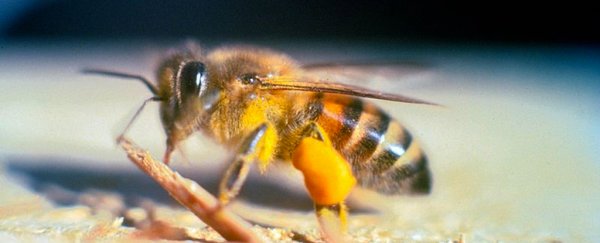A few clipped neuropeptides make all the difference between a chill honey bee and one that has an irritable need to shiv anything that moves.
To discover what makes Africanised "killer bees" so hostile, scientists from University of São Paulo State in Brazil compared their neurochemistry with those of their domesticated relatives and found it mostly comes down to a surprisingly simple chemical change.
Killer bees have something of a reputation, which – to be fair – isn't entirely undeserved.
Their venom isn't deadlier than your average honey bees, and they're actually a little smaller than their cousins. But they are aggressive, and it doesn't take much provocation to incite a swarm of them to turn into a raging, stabbing machine of pain.
Given bees are far more likely to kill you than pretty much any predatory carnivore, the more hostile variety is an animal we should really treat with caution.
These tiny striped curmudgeons appeared in the late 1950s, after Brazilian apiarists imported an African variety of Apis mellifera scutellata honey bee with a view to increase honey production.
Of course the bees didn't quite understand the fine print on their working visas, and were soon off breeding with the plain old Apis mellifera locals, creating the 'bee-grade' horror story that is legend to this day.
These aggressive hybrids have since spread as far as northern California, and remain a legitimate threat. More than a few hundred people have lost their lives to their relentless stinging.
But for all we know about their history, remarkably little is understood about what's going on in their tiny bee brains.
To get to the bottom of the mystery, the researchers in this latest study had to collect themselves a sample of killer bees - without getting murdered. They used a pretty clever trick for this.
Balls made out of thick leather were dangled near suspect bee hives, prompting large numbers to decide war was the only answer to these invading spheres of doom, and ram their stingers into the leather.
All the researchers needed to do was pluck out the angry bees and pop them into liquid nitrogen.
Bees that calmly kept a distance were also collected, frozen, and placed into a second category.
Comparing the full range of brain proteins in both categories of bee using mass spectral imaging revealed a clear, but simple difference.
One of the suspect proteins was called Apis mellifera Allatostatins A, a neuroprotein already understood to play a key role in bee learning and memory, as well as their general development.
The other group of proteins, described as tachykinin-related peptides, aren't clearly understood, but seem to influence sensory processing.
In the aggressive hybrids, these two groups of neuropeptides had been cut into shorter proteins, and were found in different clusters of brain tissue called neuropils.
To verify these proteins were significant in the bee's behavioural transformation, the researchers put a selection of non-aggressive bees to sleep and injected their brains with truncated forms of the neuropeptides.
As expected, the bees weren't exactly happy when they woke up, with the different brain chemistry thought largely to blame.
Exactly how the size and distribution of these neuropeptides leads to more aggressive behaviour is still a question to be answered, though.
Learning more about the cascade of effects these proteins have on a bee's nervous system could tell us more about the development of bee nervous systems, as well as those of insects in general.
The study was published in the Journal of Proteome Research.
